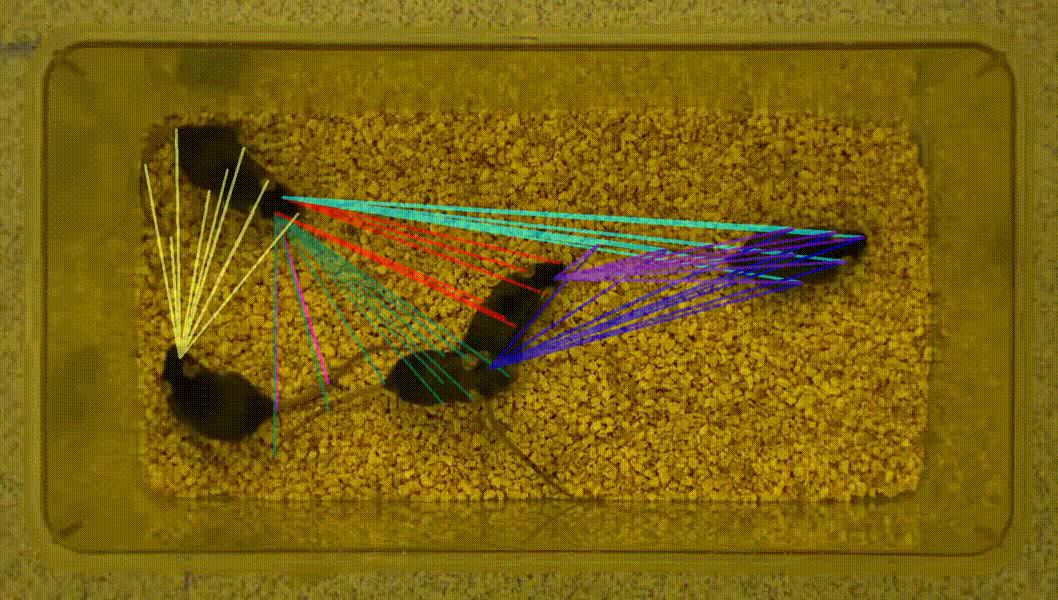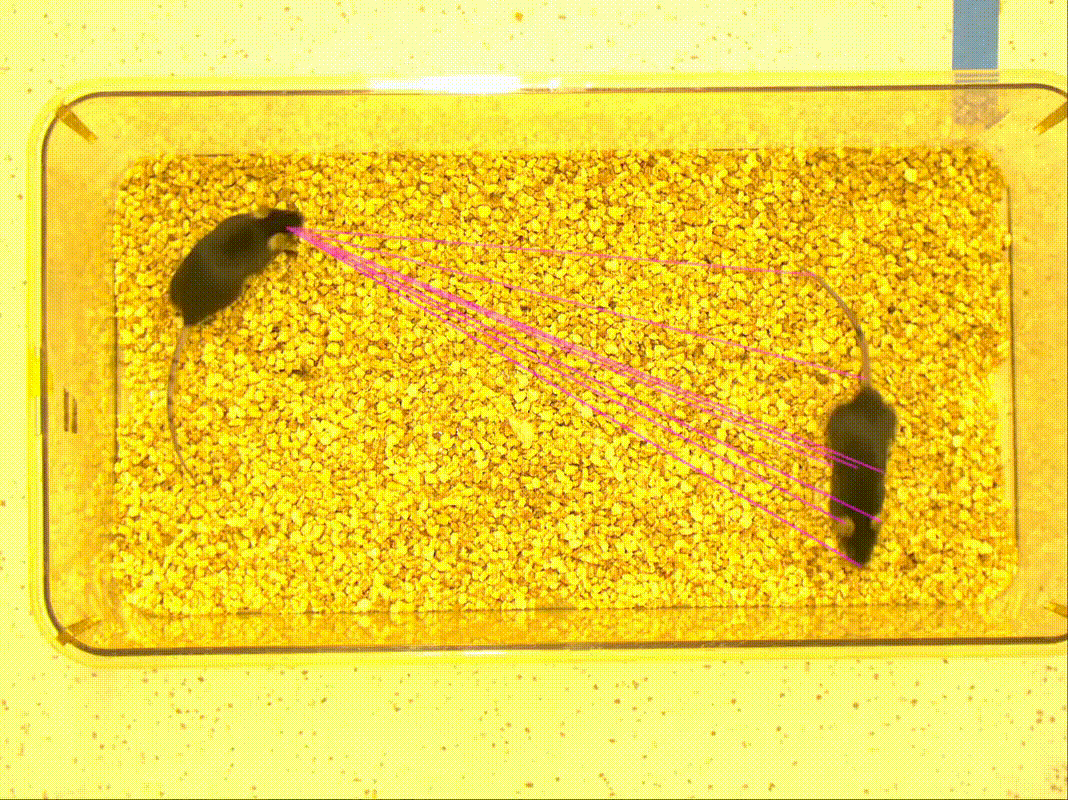Who is looking at who: calculate “directionality” between animals in SimBA
In videos containing multiple animals, it may be valuable to know when, and how much time, each animal spend directing towards each other or towards stationary objects. We can calculate this with appropriate pose-estimation data in SimBA. For a better understanding of this kind of data, and if it is relevant for your specific application, see the videos and gifs below and the rendered visualization examples at the end of this tutorial. Here we use SimBA to get measures, in seconds, of much time Animal 1 spend directing towards Animal 2, and how much time Animal 2 spend directing towards Animal 1 (… and so on for all the relationships for all the animals tracked in each video). We can also use SimBA to generate visualizations of these metrics, so that we can be comfortable with that the “directionality” data that is summarized in the created CSV files and dataframes are accurate.
Note
Firstly, and importantly, SimBA does not calculate actual gaze (this is not possible using only pose-estimation data). Instead, SimBA use a proxy calculation for estimating if the animal is directing toward another animal, or a user-defined region of interest, using the nose coordinate and the two ear-coordinates (or the equivalent coordinate on any other animal species). For more information on how SimBA estimates the location of the animals eyes, and how SimBA estimates if an object, or another animal, is within the line of sight of the specific animal, check out the [SimBA ROI tutorial - Part 3].
The pose-estimation tracking of the two ears, and the nose, of each animal, or the equivalent in other species, is required for this to work. See more information on this pre-requisite below. Furthermore, see the below image and its legend for more information on how the code in SimBA estimates the relationships between animal body-parts and/or user-defined ROIs.
[Click here for better-quality rendered MP4]
Before analyzing directionality in SimBA
To analyze directionality data in SimBA (for descriptive statistics, machine learning features, or both descriptive statistics and machine learning features) the tracking data first has to be processed the up-to and including the Outlier correction step described in Part 2 - Step 4 - Correcting outliers . Thus, before proceeding to calculate directionality-based measurements between animals in SimBA, you should have one CSV file for each of the videos in your project located within the project_folder\csv\outlier_corrected_movement_location sub-directory of your SimBA project.
- Specifically, for working with directionality between animal in SimBA, begin by
Calculate what other body-parts and what other animals, are in the line of sight for specific animal.
In the main SimBA console window, begin loading your project by clicking on
FileandLoad project. In the [Load Project] tab, click onBrowse Fileand select theproject_config.inithat belongs to your project.Navigate to the ROI tab. On the right hand side, within the
Analyze distances/velocitysub-menu, there are two buttons (circled in red in the image below) - (i) Analyze directionality between animals and (ii) Visualize directionality between animals.We will begin clicking on the
Analyze directionality between animalsbutton. Clicking on this button will calculate how much time each animal spend directing towards each other within all of your videos represented as CSV files within in yourproject_folder/csv/outlier_corrected_movement_locationdirectory. Again, for more information on how SimBA calculates directionality, check out this schematic. This schematic depicts a user-defined ROI, but exactly the same methods is applied when using body-parts rather than a user-defined ROI regions.
Once you have clicked the Analyze directionality between animals button, you can follow the calculation progress in the main SimBA terminal window.
Once the calculations are complete, several new files will be generated in your SimBA project directory. First, a new folder has been created in your project directory. If you look within the project_folder/csv/directionality_dataframes directory, you should see one new file for each of the videos in your project, each file should have the name of the video that was analyzed. If you open up one of these files, then you should see one row for each frame in your video, together with a bunch of columns representing the different animal relationships. For each animal (and by animal I mean the animal “looking” at something) and target (and by target I mean the body-part being “looked” at or directed towards), there will be a total of 5 columns. If we look at the first five column in example image just below, then the first of these five columns has the header Simon_directing_JJ_Nose and contains boolean 0 or 1 values. If the specific animal (in this case Simon) directed towards the specific body-part (in this case JJs’s nose) in that frame (i.e., the animal called Simon had the animal JJs nose within the line of sight) then the column will read 1. Conversely, if the animal (Simon) did not direct towards that body-part (JJ’s nose) in that frame (i.e., JJ’s nose was not within Simon’s line of sight), then the column reads a 0. Thus, in this example image below, animal JJs nose was within the line of sight of the animal Simon in frame 23-40, but was not within the line of sight of Simon in frame 0-22.
Next, the preceeding four columns are primarily saved for visualization purposes, should the user want to verify the data by genering rendered videos of the different “line of sight” paths. The second and third column (Simon_directing_JJ_Nose_eye_x and Simon_directing_JJ_Nose_eye_y) stores the coordinates of animal Simon’s directing eye when the specific body-part was within the line of sight. If the specific body-part was not within the line of sight, then the specific row for these columns will read 0. Lastly, the fourth and fifth column (Simon_directing_JJ_Nose_bp_x and Simon_directing_JJ_Nose_bp_y) stores the coordinates of the body-part being observed by animal Simon. If the specific body-part was not within the line of sight, then the specific row for these columns will also read 0.
Perhaps more importantly, SimBA generates a CSV log file that contains summary statistics. This includes how much time each animal spent directing towards all other animals present in the video. This file can be found in the project_folder/logs directory. This filename of this file is time-stamped, and have a name that may look something like this: Direction_data_20200822151424.csv. The content of this file should look like the image just below (if you are tracking 5 animals. if you are tracking fewer animals, then the file will contain fewer columns):
Thi log file will contain one column for each animal relationship, and one row for each analysed video. In the example screenshot above, the first column header reads JJ_directing_Simon_s and contains the time, in seconds, that the animal with the ID JJ spent directing towards the animal with the ID Simon (92.2s in the video named Video1). In column F (or column 5), with the header Simon_directing_JJ_s, we can read the time, in seconds, that the animal with the ID Simon spent directing towards the animal with the ID JJ (107.3s in Video1). Indeed, studying the directionality results in all of the four videos in the example screenshot above, the animal Simon does seems a little more interested in directing towards the animal named JJ, than the animal JJ is interested in directing towards the animal named Simon.
Note
These summary statistics are calculated based on all body-parts for each animal. If an animal is directing any body-part belonging to a specific other animal, then the animal is directing towards that other specific animal. For example, even if the animal with the ID Simon only has the tail-base of the animal with the ID JJ in the line of sight in one frame, the animal with the ID JJ is still counted as being in the line of sight in of the animal with the ID Simon.
Next, we may to visualize these directionality data - for peace of mind - that the metrics seen in the output desriptive statistics and CSV files outlined above are accurate and plausable. To do this, ga ahead and click on the second button described above - Visualize directionality between animals.
Note
Rendering videos are time-consuming and computaionally expensive. If you have many videos, many animals, and high fps/resolution, it might take some time. You can follow the progress in the main SimBA terminal window.
Once complete, you can find your final rendered videos in your project_folder\frames\output\ROI_directionality_visualize folder. For higher-quality examples of the expected final output videos for experimental scenarios containing five animals, or two animals, see the SimBA YouTube playlist.

